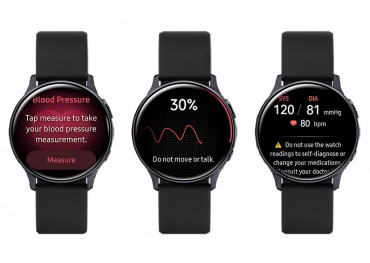
This photo taken on Jan. 7, 2020, shows a reporter looking at LG Electronics Inc.’s OLED 8K TVs at the company’s exhibition booth at the Consumer Electronics Show in Las Vegas, Nevada. (Yonhap)
SEOUL, May 22 (Korea Bizwire) — The global OLED TV market, led by South Korea’s LG Electronics Inc., is expected to post relatively small growth this year, compared with the QLED TV sector, following a disruption in panel supply caused by the novel coronavirus pandemic, a market report showed Friday.
The global OLED TV shipment is expected to increase 7.8 percent on-year to 3.375 million units this year, according to display market tracker WitsView, a research division of TrendForce.
The figure was a 26.1 percent decrease from its original number forecasted earlier this year.
OLED, or organic light-emitting diode, is highlighted by self-illuminating pixels that deliver perfect black, and it is the main display used for LG’s high-end TVs.
“The OLED TV market faces the dual headwinds of hindered panel supply and high retail prices,” WitsView said. “Both market leader LG Electronics and Sony have revised down their shipment targets for OLED TVs this year.”
Industry insiders said that production delay from LG Display Co., the sole large-size OLED TV panel supplier in the world, will weigh down the industry.
LG Display previously planned to have its OLED panel factory in Guangzhou, China, start mass production in the first quarter of the year, but it could not meet the schedule due to COVID-19 outbreak.
The company recently said it plans to fully operate the Guangzhou factory within the first half of the year.

This photo taken on Jan. 8, 2020, shows people looking at Samsung Electronics Co.’s QLED 8K TVs at the company’s exhibition booth at the Consumer Electronics Show in Las Vegas, Nevada. (Yonhap)
Industry observers said a sharp rise of QLED TVs can further limit OLED TV sales amid the pandemic.
“Aside from the pandemic-induced slowdown in OLED demand, the more flexible pricing of QLED products will also represent a substantial threat to the sales of OLED TVs this year, since the latter have historically maintained a high retail price,” WitsView said.
The global QLED TV shipment is expected to grow 41.8 percent on-year to reach 8.27 million units this year with aggressive sales promotions from the market leader Samsung Electronics Co., according to WitsView.
QLED is Samsung’s marketing term for its liquid crystal display (LCD) TVs using quantum-dot technology to enhance performance in key picture quality areas.
Although overall global TV shipment is expected to suffer 5.8 percent on-year decline to 205.21 million units this year, WitsView said QLED TV sales can increase further.
“In spite of the downturn in global TV shipment this year, the market for QLED products thrived on the flourishing stay-at-home economy as well as the sales promotions of Samsung Visual Display’s older models in the first quarter of 2020, which resulted in retail price cuts of more than 20 percent for 65-inch QLED TVs in the North American market, incidentally creating a wave of replacement demand for new TV sets,” it said.
According to market tracker Omdia, Samsung was the top TV vendor in the January-March period as it accounted for 32.4 percent of the global TV market in terms of sales value.
(Yonhap)






